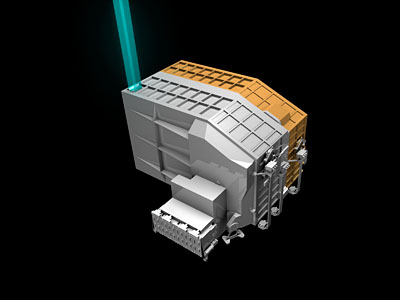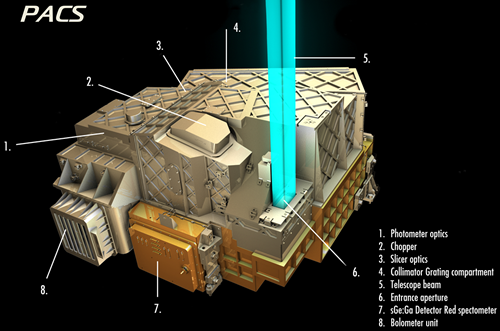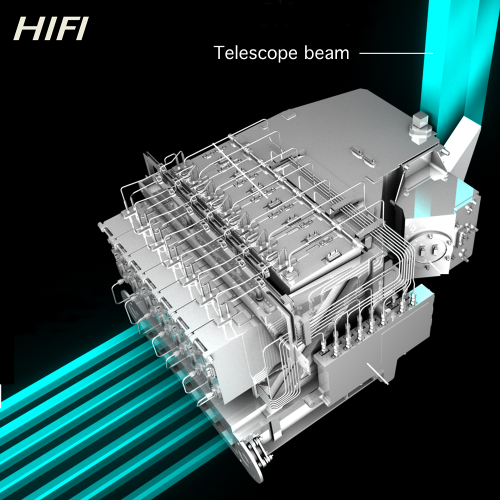There were three instruments on the Herschel space observatory. SPIRE was a camera that looks at far-infrared light, and was developed by an international consortium led by the UK. In addition, there was another camera that took pictures in far-infared light, called PACS, and an instrument like a radio receiver that tuned in to very particular wavelengths of far-infared light, called HIFI. While only PACS and SPIRE had cameras, all three instruments utilised spectrometers. This allowed the identification of individual elements and molecules in space, as well as the calculation of how fast objects are moving.

SPIRE
SPIRE took images in three ‘colours’ but at far-infrared and sub-millimetre wavelengths, providing observations at wavelengths never before attempted from space. In addition, the spectrometer allowed the detection of gases and molecules present in our Galaxy and in others, shedding more light on the process of star formation. Read more about SPIRE
Instrument Name: Spectral and Photometric Imaging REceiver
Wavelength range: 200-670 microns in 3 bands
Field of view: 4 x 8 arcminutes (camera), 2.6 x 2.6 arcminutes (spectrometer).
Number of pixels: 270 (camera), 56 (spectrometer)
Resolution: 20-30 arcseconds (camera), 20-50 arcseconds (spectrometer)
Spectrometer resolution: 300 km/s
Principal Investigator: Prof Matt Griffin (Cardiff University, UK)
Consortium Institutes: Univ. Lethbridge (Canada); NAOC (China); CEA, LAM (France); IFSI, Univ. Padua (Italy); IAC (Spain); Stockholm Observatory (Sweden); Cardiff University, Imperial College London, RAL, UCL-MSSL, UKATC, Univ. Sussex (UK); Caltech, JPL, NHSC, Univ. Colorado (USA).
More information: SPIRE website at Cardiff University

PACS
Like SPIRE, PACS took pictures in three different ‘colours’, only these ‘colours’ are different to those seen by SPIRE. Together, PACS and SPIRE see the whole range of light from far-IR to sub-millimetre, a unique and powerful combination that will not be bettered by any ground or space based mission for decades to come.
Instrument Name: Photoconductor Array Camera and Spectrometer
Wavelength range: 60-210 microns in 3 bands (2 imaged at any time)
Field of view: 1.75 x 3.5 arcminutes (camera), 50 x 50 arcseconds (spectrometer).
Number of pixels: 2560 (camera), 400 (spectrometer)
Resolution: 5 arcseconds (camera), 10 arcseconds (spectrometer)
Spectrometer resolution: 150-200 km/s
Principal Investigator: Dr Albrecht Poglitsch (MPE, Germany)
Consortium institutions: MPE (Germany); UVIE (Austria); KU Leuven, CSL, IMEC (Belgium); CEA, LAM (France); MPIA (Germany); INAFIFSI/OAA/OAP/OAT, LENS, SISSA (Italy); IAC (Spain).
More information: PACS website at MPE

HIFI
HIFI did not take pictures, instead it looked at one very small patch of sky at a time and spread the light out so that we could see the whole rainbow of far-infrared light (the spectrum). By spreading the light out HIFI showed us the tell-tale signatures of different chemicals that exist in space, including water.
Instrument Name: Heterodyne Instrrument for the Far Infrared
Wavelength range: 157-625 microns in 7 bands (corresponding to 480-1910 GHz)
Resolution: 13-40 arcseconds
Spectrometer resolution: 0.02-0.7 km/s
Principal Investigator: Thijs de Graauw (SRON)
Consortium institutions: CSA, U. Waterloo (Canada); CESR, LAB, LERMA, IRAM (France); KOSMA, MPIfR, MPS (Germany); NUI Maynooth (Ireland); ASI, IFSI-INAF, Osservatorio Astrofisico di Arcetri-INAF (Italy); SRON, TUD (The Netherlands); CAMK, CBK (Poland); Observatorio Astronómico Nacional (IGN), Centro de Astrobiología (CSIC-INTA) (Spain). Chalmers University of Technology – MC2, RSS & GARD, Onsala Space Observatory, Swedish National Space Board, Stockholm University – Stockholm Observatory (Sweden); ETH Zurich, FHNW (Switzerland); Caltech, JPL, NHSC (USA).
More information: HIFI website at SRON
.
